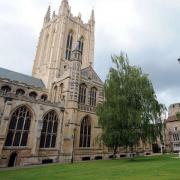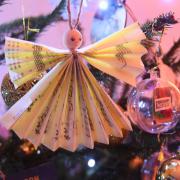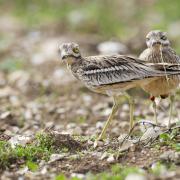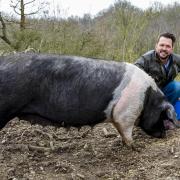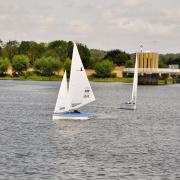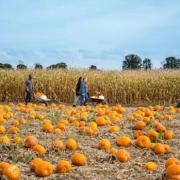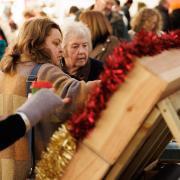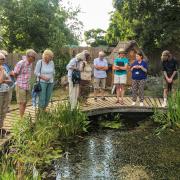From Lowestoft to Felixstowe, Suffolk has a varied and picturesque coastline which attracts thousands of visitors every year. Our coast is also a vital habitat for a variety of marine life, including the UK’s two resident seal species.
In February, the National Trust announced the exciting news that Suffolk now has an established grey seal colony at Orford Ness. Rangers have been monitoring and protecting seals there since they first appeared during the winter of 2021/22 when about 200 grey seals were seen.

The pregnant females, known as cows, haul out of the sea in late autumn to give birth to their pups. During that first season, 25 newborns were counted at Orford Ness. Last winter the number of seals in the colony, strangely referred to as a rookery, had increased to approximately 500 adults, with 130 pups recorded.
The pups, known as whitecoats, feed on their mother’s milk for about three weeks. This milk consists of 60 per cent fat, so the youngsters grow rapidly putting on up to 2kg a day. The mother may return to the sea briefly between suckling bouts, but she rarely feeds and loses up to a quarter of her body weight whilst nursing her pup.

Any disturbance from people or dogs during these early weeks might cause the mother to abandon her pup, leaving it to starve. Even with minimal disturbance, pup mortality is high; between 20 per cent and 40 per cent don't survive their first year.
The pups are weaned after losing their baby coat at three to four weeks of age. The females break the maternal bond, leaving their offspring on the beach while they swim out to sea to feed. The youngsters must now grow a smooth, waterproof adult coat, which can take another three weeks. During this period they are still very vulnerable and reliant on their fat reserves.

Among hazards are now many huge, testosterone charged males on the beaches, throwing their considerable weight around. The grey seal bulls, which can weigh 50 per cent more than the cows, usually begin arriving at the rookery as the first pups are born.
After giving birth, the cows are ready to mate again and start the next breeding cycle. Mature bulls compete to become 'beachmasters', giving them exclusive access to a group of between two and 10 females. During these battles the largest and most experienced males usually prevail, but significant injuries can be inflicted by both combatants, in savage duels, before one of the animals concedes and retreats.

Our other seal species, the harbour seal, is also known as the common seal. These days, this is something of a misnomer as their population in Britain is much smaller than that of their grey seal cousins. Harbour seals are smaller and more streamlined, but it can still be surprisingly difficult to tell them apart.
Both show vast variation in the colour of their coat, ranging from pale grey or beige to almost black, with speckled or blotched markings common across the two species. Binoculars may be required to reveal the most distinguishing features, which are on the head.

Harbour seals have a rounded, cat-like face, with V-shaped nostrils, and eyes comparatively close to the nose. The greys have an elongated, flattish muzzle, with nostrils almost parallel, and their eyes are halfway along the length of the head.
The reproductive behaviour of harbour seals is markedly different from that of the massed grey seal breeding colonies. Harbour seals mate in June and July and the cows give birth, usually on a sandbank, approximately a year later. Unlike grey seal pups, newborn harbour seals are able to swim within hours and soon take to the water accompanied by their mother.

The cow suckles her youngster for a minimum of three weeks, after which the infants are literally in at the deep end, having to provide for themselves and lead an independent life.
Like the grey seal cows, harbour seal females will mate again soon after weaning their pup. Due to this more 'secretive' breeding behaviour, harbour seals are much less noticeable on our beaches, although individuals may occasionally be seen mingling within grey seal rookeries.

I've been photographing grey seal breeding rookeries in North Norfolk for many years and I consider this annual mass 'invasion' of our beaches to be one of the country’s greatest wildlife spectacles. Although the establishment of a new colony in Suffolk is warmly welcomed by nature lovers, local seal guardians are worried for the future welfare of newborns.
With potentially hundreds of vulnerable whitecoats on our beaches during winter months, local representatives of a UK charity are raising concerns that they need to prepare for an influx of young seals requiring assistance. Jo Collins, a volunteer medic with the British Divers Marine Life Rescue (BDMLR) is all too aware of the challenges involved in keeping the county’s seals safe and healthy.

'In the year between 2022/2023 we cared for 20 seal pups in the rescue unit at Trimley St Martin; by 2023/2024 the number had increased to 55,' she explains. 'I am working along with a colleague to try and gain funding to expand the existing facilities and would welcome any available support. We also need more volunteers to assist with rescues and the associated after care of the pups.'
BDMLR run training days where volunteers learn how to rescue seals and re-float larger marine mammals, such as dolphins and whales. These Marine Mammal Medic Courses are open to anyone over 18 and you don’t have to be a diver.

After the latest breeding season, with most of the seals dispersed, I got an invitation from Matt Wilson, a countryside manager with the National Trust, to visit Orford Ness and photograph these large marine mammals. I was met by senior communications officer Becky MacNaughton and area ranger Andrew Capell, my guide for the afternoon.
It was Andrew who first sighted the seals on Orford Ness back in 2021. We were given access to an area normally out of bounds, but I still needed a telephoto lens to get my photos. As we walked across the shingle we spotted a small group of seals further up the beach, but not wanting to disturb them we settled down to watch a few seals swimming just offshore.

Within minutes we had an audience of eight of the buoyant marine mammals bobbing their heads out of the water to get a better view us. I identified a mature bull from its sheer size; Andrew also recognised adult females and some juveniles in the group. As I photographed the seals frolicking in the sea, individuals occasionally hauled themselves out onto the shore to get a closer look at their strange visitors.
Eventually, curiosity got the better of a female. She pulled herself up the beach and cautiously peered over the ridge of shingle, looking straight into my lens. After a minute the inquisitive seal seemed satisfied that I was not a threat, but also of no interest, and made her way through the surf back into the water.
Andrew explained that the unexpected appearance of the Orford seal colony was a totally natural event, and the first individuals were probably 'overspill' from the Norfolk population. Just like BDMLR, the National Trust has concerns about future disturbance to the seals and particularly the pups.

'Even something as simple as standing on the beach between a pup and the water may mean that its parent won’t return until you’ve gone, so just getting too close to the seals could have unintended consequences,' he cautions.
Grey seals are thriving, both locally and nationally; from a low point of only 500 in the early 20th century, it's estimated that there are now more than 120,000 grey seals around Britain. This represents 40 per cent of the world's population and 95 per cent of the European population.
But it's vital that human intrusion to the colonies is controlled and limited to protect the animals during their critical pupping season. Ever increasing plastic pollution in our seas is another hazard to our seals and other marine life. We can all play our part by taking our rubbish home with us when we visit the coast.

How to watch seals - no close-ups, no children, no dogs
The BDMLP advises never to approach a seal, or allow children or dogs near a seal. As wild animals, while they look cute, they will defend themselves aggressively if necessary.
If you find a seal on a beach, watch it from a distance. Seals regularly haul out on our coasts as part of their normal behaviour and spend more time out of the water, digesting their food and resting, than in it.
If you're concerned about a seal, contact BDMLR on the rescue hotline 01825 765546.

Both grey seals and common or harbour seals are protected species and there is legislation covering their illegal harm, taking or killing. Organisations including the BDMLR and the Seal Alliance are campaigning for seals to be given legal protection from intentional and reckless disturbance.
Disturbance causes seals huge metabolic and physical damage when they stampede and tombstone into the sea. Research shows they are disturbed 68 per cent of the time when people are present.

In April 2022, the Joint Nature Conservation Committee's 7th Quinquennial Review recommended seals be added to Schedule 5 of the Wildlife and Countryside Act, which would make seal disturbance illegal. Lack of action led the Seal Alliance to help secure a ‘Seal Protection’ Debate in Parliament last year.
The following day, the EFRA Committee’s report ‘Protecting Marine Mammals in the UK and Abroad’ was released emphasising the importance of seals being added to Schedule 5 of the Wildlife and Countryside Act as soon as possible.




